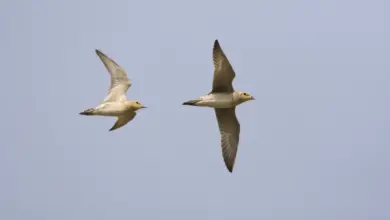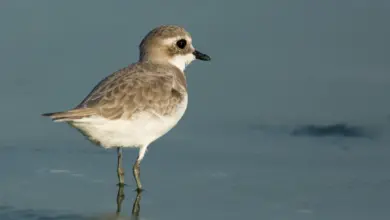What Is Cloaca in Birds? Do Birds Poop and Pee In From the Same Hole?
The cloaca is a very important orifice needed for most of its daily functions. We shed some light on what is cloaca and what functions it performs in a bird’s body.
Birds are very different from mammals in many ways, one of which is their mating process.
The cloaca is a vent that birds use while mating instead of using genitalia like other animals.

Credits: Jared Yelton, original uploader was Redtailed at en.wikipedia, Public domain, via Wikimedia Commons
Most domestic and wild birds have a cloaca. If you look at male birds, only 3% of the total number of bird species have functional and formed penises!
The cloaca has many functions in birds; we will explore these uses in more detail in the article below.
What Is Cloaca and What Do Birds Use It For?
The cloaca is where birds reproduce, urinate and even excrete feces. Birds have this unique vent where all three: reproductive systems, urinary system, and digestive tract ends.
Birds have it in their lower abdomen, usually hidden under their plumage. Besides the three things we mentioned, birds use the cloaca for thermoregulation (maintaining their body temperature).
From a veterinary point of view, the cloaca is also important for conducting various medical tests on birds. A cloacal sample can help to determine gut health in birds.
Let’s explore all this in more detail:
Mating
Birds use their cloacas during the mating period, and this part of their anatomy plays a vital role in reproduction. So important that mating in birds is called the “cloacal kiss.”
Before mating, there is a period of courtship during which male birds try to attract females through various means – their colorful plumage, strong physical abilities, matings dances, and many other things.
During this time, the cloacas swell up a bit, which lets them come out from under the plumage. When mating, the male bird will mount the female bird so that their cloacas can touch.

This is known as the “cloacal kiss,” which lasts only a few seconds, unlike humans (though I’m sure both men and women reading this article will have their version of how long humans mate).
During the cloacal kiss, the male bird releases sperm which travels up the female’s reproductive tract and fertilizes the egg.
Urine and Feces
Apart from its reproductive connection, the cloaca is also the end of the urinary and digestive tracts.
Because there is only such vent (or hole, if you will), birds don’t pee and poop through separate areas in the body.
If you have ever had bird poop fall on you, you would have noticed that it’s white.
One unique feature about birds is that they are “Uricothelic organisms.” Let me explain that one for the less technically inclined.
Unlike humans, who convert ammonia in their food to urea (which comes out as part of our poop), birds convert ammonia to either guanine (guano) or uric acid, which comes as a white paste when they excrete.
Converting to uric acid makes the excretion less toxic to them, and it also helps them retain more water.

Cooling
While the cloaca is a part of the reproductive organs, it also has a role in maintaining birds’ temperature. Scientists have found that enough water can evaporate from the cloaca to help birds keep their temperatures steady. This way, the cloaca helps birds stay cool in particularly warm areas.
Veterinary Purposes
Researchers and veterinarians often take a cloacal swab sample to determine issues within the digestive tract or to check for viruses.
It helps prepare and check viral cultures or tests for pathogens, especially because the cloaca can host various microbial communities.
Is it the Same in Males and Females?
The structure of the cloaca is the same in both male and female birds; however, while it may look the same in most birds, its function as a reproductive organ is different between males and females.
Since the cloaca is the same for both males and females, their medical conditions are also similar.
A condition that can occur in any bird with a cloaca is cloacal prolapse, where the cloaca gets misplaced, exposing the inner tissue.

Birds That Don’t Have a Cloaca
There is a lot of diversity in bird species, and it is not limited to their physical appearances.
Birds may have different plumage, varied habits, and anatomical differences. Therefore, some birds don’t have a cloaca but instead have genitalia.
Birds that don’t have a cloaca include:
- Ducks
- Swans
- Ostriches
- Geese
- Cassowaries
These birds have penises and clitorises, but not in the way you and I think.
For example, male ducks and swans have a penis that is not a different organ but an extension of the cloaca.
Other male birds, like ostriches and geese, have a phallus that they use for mating and reproduction.
Why Don’t Most Birds Have Penises?
If you observe the changes in a developing bird embryo, you will notice that the cells that should go on to form a penis die during gestation. Recent studies have pointed toward a possible cause for this.
Scientists have observed the development of bird embryos, especially during the stage when the reproductive organs and the genital tract form.
They found that birds have a gene that triggers the death of the penis cells. Bird embryos have Bmp4 (bone morphogenetic protein 4). When the gene triggers this protein synthesis, it causes the penis cells to die.
Frequently Asked Questions
What is the cloacal kiss in birds?
The male bird climbs onto the female so that their cloacas can touch.
The male then transmits its sperm during the cloacal kiss. The cloacal kiss occurs in most domestic and wild bird species.
Can humans have cloaca?
The cloaca soon divides into separate reproductive and urinary organs.
Cloaca sequencing is often done if there is a malformation in the bird. Cloacal dysgenesis sequenceis one such rare malformation.
How does an egg come out of a bird?
What animals have a cloaca?
Wrap Up
The cloaca of birds is vital for almost all body functions in birds that require an opening. Even birds with genitalia have penises or clitorises as a part of the cloaca or made from the cloacal walls.
Therefore, this area of bird anatomy has been the subject of much interest and research. We hope that this article has been informative and useful. Thank you for reading.




